At CTS Service Solutions, we believe one of the best ways to improve customer experiences is by making interactions ad easy as possible and by decreasing the hassle-factor.
Enter live chat.
Live chat contains a number of attributes that contribute to hassle-free experiences. From ease of first contact, to low-to-no hold times, to the convenience of customers interacting with service reps while performing other tasks, live chat offers an opportunity for organizations to assist customers quickly, easily, and cost effectively.
Live chat allows organizations to assist online customers in real time. When customers run into a problem, the customer can immediately take advantage of the live chat feature, interact with reps, and hopefully have their question answered or issue resolved quickly.
Live chat seems like a no-brainer.
However, investing in a new or lightly staffed customer service channel comes at a cost. Live chat is not for every customer, or every organization. Using data from a recent Software Advice report (link no longer active), we have formulated three questions to help you determine if live chat might be an effective channel for your customers.
Although live chat has been around awhile and 56 percent of respondents in this survey said they have used it at least once, usage of the technology still skews heavily towards younger consumers.
According to the research, 56 percent of respondents aged 18 to 34 prefer live chat to phone, compared to 27 percent of respondents aged 35 and older.
If much of your customer base is made up of Millennials, live chat is likely to be not just appreciated but even expected.
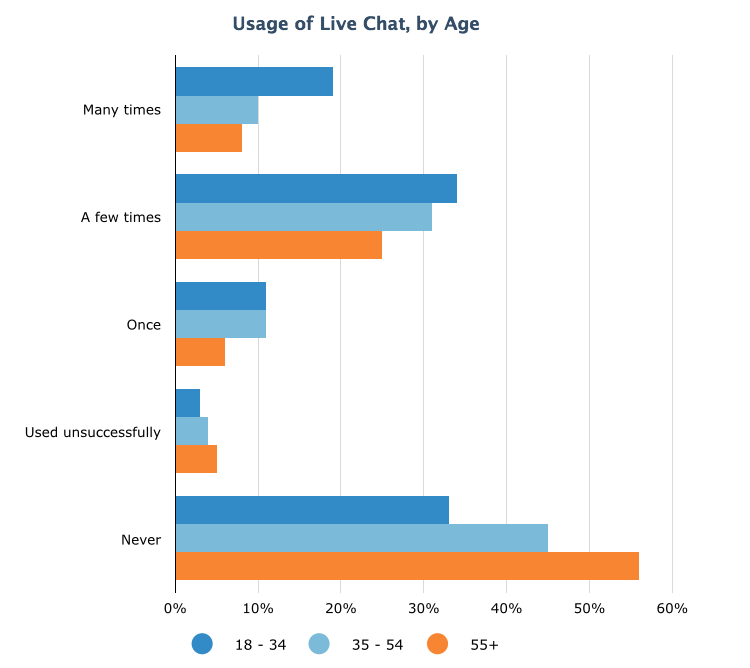
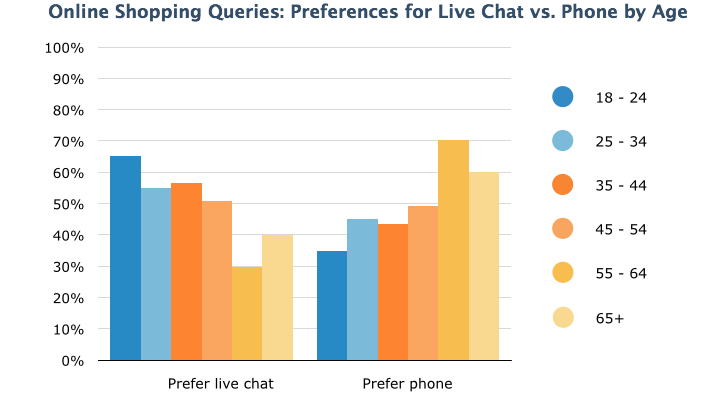
When you look at your customer’s journey, do you find touch points that tend to generate a high number of customer questions? Do you find online shopping carts being abandoned at certain points in the sales process? Depending on the complexity of the reasons, these two scenarios might be perfect places to implement a live chat window.
Despite the age skew, the research shows that customers are open to using live chat for simple inquiries.
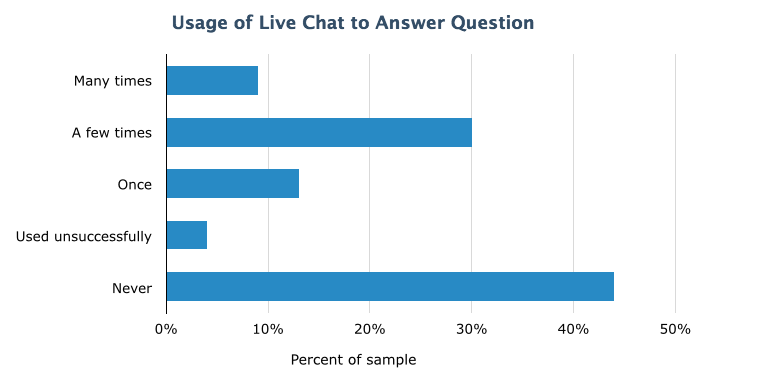
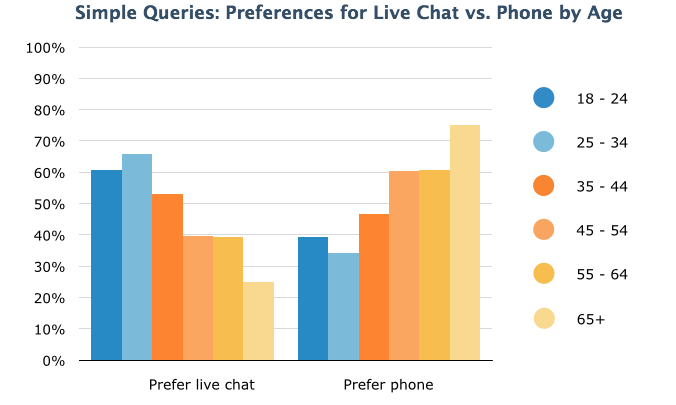
Many organizations or departments deal with questions or service issues that are complex or sensitive in nature. According to the charts above, the preference of phone versus live chat for simple questions or online shopping queries is fairly equal. But the numbers change for customers with financial queries; they prefer to have issues addressed by phone.
As seen below, 49 percent of respondents prefer using live chat for online shopping questions, yet only 26 percent prefer chat for financial questions.
If your company deals primarily with sensitive information, live chat might not be the most effective channel.
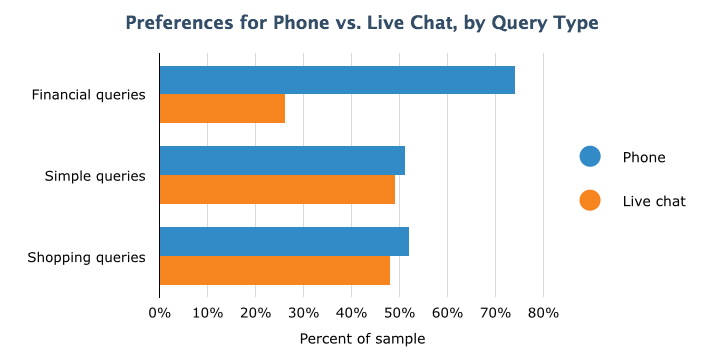

Of course, these questions are just a start. More detailed questions of technology, cost, scale, and organizational buy-in will inevitably be part of any discussion. However, with the many benefits live chat can create for your customers’ experiences, the three questions above should provide a good starting point for evaluating live chat’s potential usefulness to your organization.
Charts courtesy of the help desk reviews and comparisons company Software Advice (link no longer active).
Comments are closed.
© 2011-2025 CTS Service Solutions, LLC.
All rights reserved.
Legal Information | Privacy Policy
How to Cite this Site
Great questions Adam! I’d add a further one – do you have the resources to staff web chat when your customers want it? Our own research found that too many companies advertised live chat but then failed to follow through at peak times, shutting it down as all agents were busy on other channels. This risks creating the opposite effect – annoying customers rather than delighting them. More in this Eptica blog post http://www.eptica.com/web_chat_time_uk_brands_reap_benefits
That’s a great point Pauline. You’ve got to have the resources adequately deployed. Thanks for weighing in!
Whilst I do love the idea of online chat services, more for the ease than anything to be completely honest, I have found them to be very hit and miss a lot of the times. At the best of times I was able to get a lead and close the sale with one conversation and the worst of times I spent a lot of my time being wasted by people who had no real intent of purchasing – this is where I began looking into what qualification questions could be asked before I opened the chat!
That’s an interesting point from the organization’s side Marius. Does the company’s view of the chat channel match how the customers are using it?
Adam, it’s great that you provided certain charts about the different type of questions and queries agents get from clients. I myself am thinking about going into a live answering service mainly because of my passion of helping people out. Well, would all live answering services provide a live chat feature?
Hey Correy, Thanks for your comment! I think the answer to that question really relies on the industry, the business model, and the specific customer base. Generalizations are tough, and I would think that there are still a number of businesses where live chat might not yet be viable from an ROI standpoint.
I agree that these are some great questions to ask before deciding on answering services, whether they be via chat or over the phone. You definitely want to make sure that whatever service you hire fits your business needs and is also equipped to handle you target audience. Even though answering doesn’t see to be an essential part of your customers’ experience with your company, it certainly is a huge contributing factor for the overall perception they have of your product or service.
Great points Gerald! Thanks for stopping by.
I found it somewhat surprising that the young adult age group preferred live chat far more than older adults did. That being said, I think the appeal of a live chat is that you are able to talk to a representative without the effort of using a phone, which would certainly be an attractive quality for me. There are many different techniques for making customer service more effective, and I think live chat may be the future of that. Do you think this method of communication with stores and services will replace phones anytime in the near future?
Thanks for sharing Audrey. It’s hard to imagine live chat will replace phone completely anytime in the foreseeable future, but I do think it will continue to increase in importance.
I agree. While live chat is becoming more efficient and more popular, phones are still too traditional and classic to be replaced completely. It’s interesting to see your view point on it, however.
In my experience working tech support, we got higher live chat volume than anything else. People like to use it for quick questions that they don’t want to spend 5+ minutes on hold to get answered. For the longer questions or issues, people used our phone service.
That makes sense Veronika. That is how I see the platforms functioning as well. Thanks for joining the conversation!
It sounds like the age group and good questioning are what would some of the touching points to maybe talk to my team about. Having worked for a live phone chat group it’s what has me wanting to teach them. Also, the points would be our main focuses of improving our sales goal.
Great advice for increasing customer loyalty. Recognizing your target audience and their needs will get you going in the right direction. Thanks so much for sharing!
Appreciate it Drew!
Pingback: 265: (Tip) Chatbots and Humans